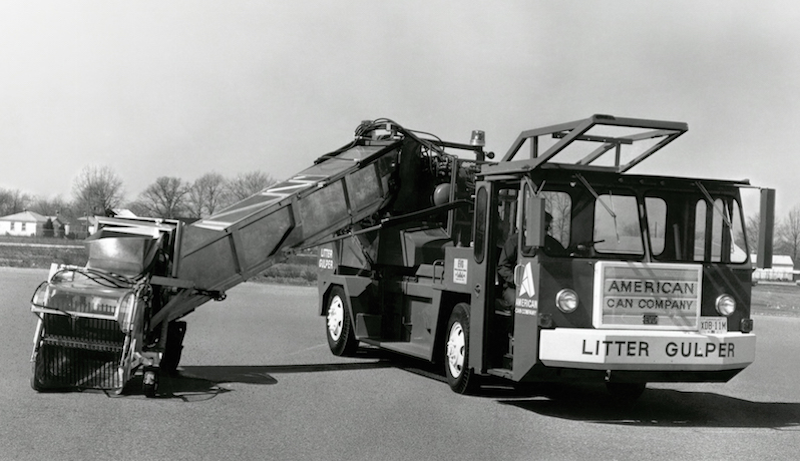 
Litter Gulper
Built for The American Can Company
by Pioneer Engineering & Manufacturing Co., Warren, Michigan

The Litter Gulper Mark II attachment on EVO Lodal refuse truck
The early 1970s saw an increased public awareness in ecology, which spawned a public service campaign against roadside litter in the United States. The "Pitch In" logo soon began appearing on refuse receptacles, and the memorable television PSA showing the American Indian weeping as motorists tossed trash out of their windows became emblematic of the movement. At the same time, technological developments in refuse collection equipment were just breaking out, such as the Son of Godzilla, the Gulf MBR, The Jumping Bean and the Glen Myers autoloader.
Out of this came the Litter Gulper, the creation of Jerry Fleming of Oroville, Washington. This device was an attachment arm which was coupled to a conventional refuse packer, and was designed to patrol highways and automatically pick up roadside refuse without the driver ever leaving his vehicle. Fleming built his own prototype, and later a working prototype was commissioned based on his design by The American Can Company, a producer of packaging (primarily beverage containers) which made up a large part of highway litter. The finished product, dubbed the "Mark II", was built by Pioneer Engineering & Manufacturing of Warren, Michigan. Pioneer was the largest and oldest engineering firm in Detroit, and had long worked with the major auto manufacturers based there. Starting with a standard Lodal EVO unitized side loader, Pioneer added a 17-foot reach loader arm with a conveyor belt which emptied into the hopper of EVO. At the opposite end, the opening was fitted with compressed air jets and a sweeper to dislodge and lift loose rubbish (including bottles and cans) on to the conveyor, at a working height of up to 4-feet above street level. The dual steering controls of the EVO made the operation easier from the right-hand drive position, while left-hand drive could be used to-and-from the job.
The Litter Gulper was a novel and timely idea, but except for this prototype, there is no evidence that any more copies were ever built. The Litter Gulper received some mainstream and trade press coverage in 1972, but ultimately was probably too expensive for most municipalities. It was a novel idea, and timely, but probably was just too cumbersome and expensive for the job it performed. It remains today as a mechanized footnote in the 1970s ecology movement, a cross between a road sweeper and a refuse truck.
REFERENCES
American City Magazine, September 1972, page 12 "Roadside Litter Gulper"
|

1/7/17
© 2017
All Rights Reserved
Photos from factory brochures/advertisements except as noted
Logos shown are the trademarks of respective manufacturers
|
| |